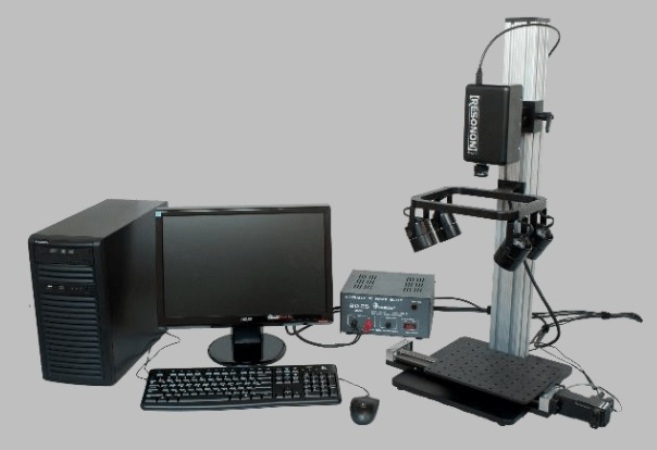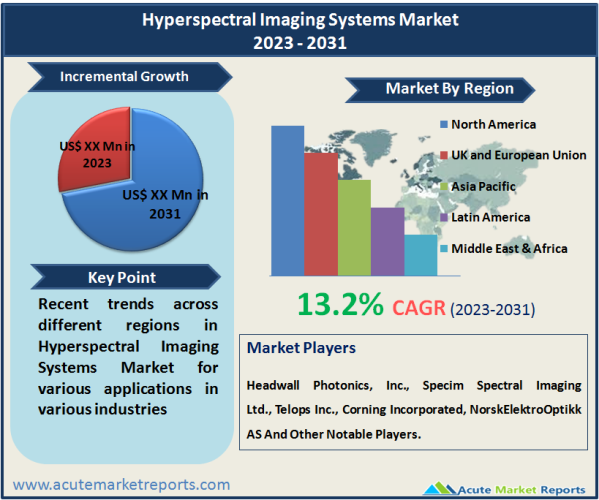
The market revenue for hyperspectral imaging systems is expected to grow at a CAGR of 13.2% during the forecast period of 2025 to 2033, due to the growing adoption of this technology in precision agriculture and remote sensing applications. In precision agriculture, hyperspectral imaging helps farmers and agronomists assess crop health, detect diseases, and optimize resource management by providing precise and actionable information about crop conditions. The ability to identify crop stress, nutrient deficiencies, and pest infestations has proven valuable in increasing agricultural productivity and reducing resource wastage. Moreover, the healthcare sector has been a key driver of the Hyperspectral Imaging Systems market. Hyperspectral imaging has shown immense potential in medical diagnostics, wound assessment, and tissue analysis. Its non-invasive nature and ability to provide detailed spectral data about tissues and cells have made it a valuable tool in medical research and clinical applications. The technology has been explored for the early detection of diseases, improving surgical outcomes, and aiding in the diagnosis and monitoring of various medical conditions. The Hyperspectral Imaging Systems market has also witnessed growth in environmental monitoring applications. Hyperspectral cameras are used to analyze water quality, detect pollution, monitor vegetation health, and assess ecosystem changes. This capability has become crucial in addressing environmental challenges and supporting sustainable resource management.

Advancements in Imaging Technology
Advancements in imaging technology have been a significant driver of the Hyperspectral Imaging Systems market. Over the years, there have been notable developments in hyperspectral cameras, sensors, and data analysis algorithms, leading to improved system performance and data accuracy. For instance, the introduction of miniaturized hyperspectral cameras has made the technology more accessible and portable, allowing for its integration into unmanned aerial vehicles (UAVs) and handheld devices. These advancements have expanded the application possibilities of hyperspectral imaging, enabling its use in various industries, such as precision agriculture, environmental monitoring, and healthcare. Evidence of this driver can be found in research papers and academic publications detailing the technological improvements in hyperspectral imaging systems.
Increasing Demand for Precision Agriculture
The growing demand for precision agriculture has been a key driver of the Hyperspectral Imaging Systems market. Precision agriculture involves using technology to optimize agricultural practices, improve resource utilization, and maximize crop yields. Hyperspectral imaging plays a crucial role in this field by providing detailed information about crop health, nutrient deficiencies, and pest infestations. By accurately assessing crop conditions, farmers can implement targeted interventions, such as precise application of fertilizers and pesticides, leading to improved efficiency and reduced environmental impact. Evidence supporting this driver can be found in reports from agricultural research institutions and case studies demonstrating the effectiveness of hyperspectral imaging in precision agriculture applications.
Expanding Applications in Healthcare
The expanding applications of hyperspectral imaging in the healthcare sector have also contributed to the growth of the market. Hyperspectral imaging's non-invasive nature and ability to capture detailed spectral information from tissues and cells have made it valuable in medical diagnostics and research. The technology has been explored for the early detection of diseases, wound assessment, and tissue analysis. For example, in dermatology, hyperspectral imaging has shown promise in diagnosing skin conditions and monitoring treatment progress. In surgical settings, it has been used to identify tumor margins and aid in surgical decision-making.
Cost and Complexity of Implementation
One significant restraint affecting the Hyperspectral Imaging Systems market is the high cost and complexity of implementation. Hyperspectral imaging systems require specialized hardware, including hyperspectral cameras and sensors, as well as advanced data analysis software. These components can be expensive to acquire and maintain, making the technology less accessible to smaller businesses and organizations with budget constraints. Moreover, the data generated by hyperspectral imaging is vast and complex, requiring skilled personnel and significant computational resources for analysis. The complexity of data interpretation and the need for specialized expertise can pose challenges to users, particularly those who are not familiar with hyperspectral imaging technology. As a result, some potential users may be deterred from adopting hyperspectral imaging systems, limiting the market's growth.
Cameras Dominate the Market by Product Category
The Hyperspectral Imaging Systems market is segmented based on products into two main categories: Cameras and Accessories. Among these segments, the Cameras category exhibited the highest revenue share in the market in 2024. Hyperspectral cameras are the primary components of imaging systems that capture detailed spectral information from a wide range of electromagnetic wavelengths. These cameras are equipped with specialized sensors and optics to acquire hyperspectral data, making them essential for various applications in precision agriculture, environmental monitoring, and healthcare. The increasing adoption of hyperspectral imaging technology in these industries contributes to the high revenue generation for the Cameras segment. However, it is the Accessories segment that demonstrates the highest CAGR in the Hyperspectral Imaging Systems market during the forecast period of 2025 to 2033. Accessories include a wide range of supporting components and peripherals that complement hyperspectral cameras, enhancing their functionality and versatility. These accessories may include lenses, filters, illumination sources, and data storage solutions. As the demand for hyperspectral imaging expands across different industries, the need for specialized accessories to optimize imaging performance and data analysis capabilities rises. This drives the growth of the Accessories segment, as users seek to enhance the capabilities of their existing hyperspectral imaging systems through the integration of compatible accessories.
Push Broom Technology Dominates the Market by Technology
The Hyperspectral Imaging Systems market is segmented based on technology into three main categories: Push Broom, Snapshot, and Others. Among these segments, the Push Broom technology category held the highest revenue share in the market in 2024. Push Broom hyperspectral imaging systems use linear array detectors to capture continuous spectral data along a single direction as the sensor moves over the scene. This technology is well-suited for applications that require high spatial and spectral resolution, such as remote sensing and precision agriculture. The ability of Push Broom systems to acquire data with minimal image distortion and high efficiency contributes to their widespread adoption and revenue generation in the market. However, it is the other segment that is expected to exhibit the highest CAGR during the forecast period of 2025 to 2033 in the Hyperspectral Imaging Systems market. The Others category includes various emerging and innovative hyperspectral imaging technologies beyond the conventional Push Broom and Snapshot methods. These may include technologies like tunable filter-based hyperspectral imaging, which enables selective wavelength tuning for specific applications. As research and development in hyperspectral imaging continue to progress, new technologies are being explored to overcome limitations and improve data acquisition efficiency. The growing interest in these alternative technologies contributes to the high CAGR of the Others segment.
North America Remains as the Global Leader
North America held the highest revenue percentage in the market in 2024. The region's dominance can be attributed to the presence of established players in the hyperspectral imaging industry, strong investments in research and development, and the widespread adoption of hyperspectral imaging technology in various sectors, including agriculture, environmental monitoring, and healthcare. Additionally, the presence of advanced healthcare infrastructure and the increasing use of hyperspectral imaging in medical diagnostics have contributed to North America's high revenue share. However, it is the Asia-Pacific region that exhibits the highest CAGR in the Hyperspectral Imaging Systems market during the forecast period of 2025 to 2033. The Asia-Pacific region has been witnessing rapid economic growth, urbanization, and industrialization, leading to increased demand for advanced imaging technologies. Countries like China, India, and Japan have been at the forefront of adopting hyperspectral imaging in agriculture, mining, and environmental monitoring. The rising awareness of the benefits of precision agriculture and the need for sustainable environmental practices have driven the growth of hyperspectral imaging systems in this region.
Market Competition to Intensify during the Forecast Period
The Hyperspectral Imaging Systems market is characterized by intense competition among several key players, each striving to gain a significant market share. Some of the top players in the market include Headwall Photonics, Inc., Specim Spectral Imaging Ltd., Telops Inc., Corning Incorporated, and NorskElektroOptikk AS, among others. These companies are leading the market by leveraging their technological expertise, extensive research and development capabilities, and strong distribution networks. To maintain their competitive edge and drive growth, these players have adopted several key strategies. One of the prominent competitive trends in the Hyperspectral Imaging Systems market is continuous product innovation and development. Leading players invest significantly in research and development to enhance the performance and capabilities of their hyperspectral imaging systems. They focus on developing compact, lightweight, and high-resolution hyperspectral cameras with improved data analysis algorithms. By offering cutting-edge technology, these companies attract a wide range of customers across various industries, including agriculture, healthcare, and environmental monitoring. Strategic partnerships and collaborations are also prevalent among top players in the Hyperspectral Imaging Systems market. These companies often form partnerships with research institutions, academic organizations, and government agencies to strengthen their research capabilities and gain access to new technologies. Collaborations with distributors and channel partners help expand their global reach and increase market penetration. These strategic alliances enable players to access new markets and enhance their product offerings to cater to diverse customer demands effectively.
Historical & Forecast Period
This study report represents analysis of each segment from 2023 to 2033 considering 2024 as the base year. Compounded Annual Growth Rate (CAGR) for each of the respective segments estimated for the forecast period of 2025 to 2033.
The current report comprises of quantitative market estimations for each micro market for every geographical region and qualitative market analysis such as micro and macro environment analysis, market trends, competitive intelligence, segment analysis, porters five force model, top winning strategies, top investment markets, emerging trends and technological analysis, case studies, strategic conclusions and recommendations and other key market insights.
Research Methodology
The complete research study was conducted in three phases, namely: secondary research, primary research, and expert panel review. key data point that enables the estimation of Hyperspectral Imaging Systems market are as follows:
Market forecast was performed through proprietary software that analyzes various qualitative and quantitative factors. Growth rate and CAGR were estimated through intensive secondary and primary research. Data triangulation across various data points provides accuracy across various analyzed market segments in the report. Application of both top down and bottom-up approach for validation of market estimation assures logical, methodical and mathematical consistency of the quantitative data.
| ATTRIBUTE | DETAILS |
|---|---|
| Research Period | 2023-2033 |
| Base Year | 2024 |
| Forecast Period | 2025-2033 |
| Historical Year | 2023 |
| Unit | USD Million |
| Segmentation | |
Product
| |
Technology
| |
Application
| |
|
Region Segment (2023-2033; US$ Million)
|
Key questions answered in this report